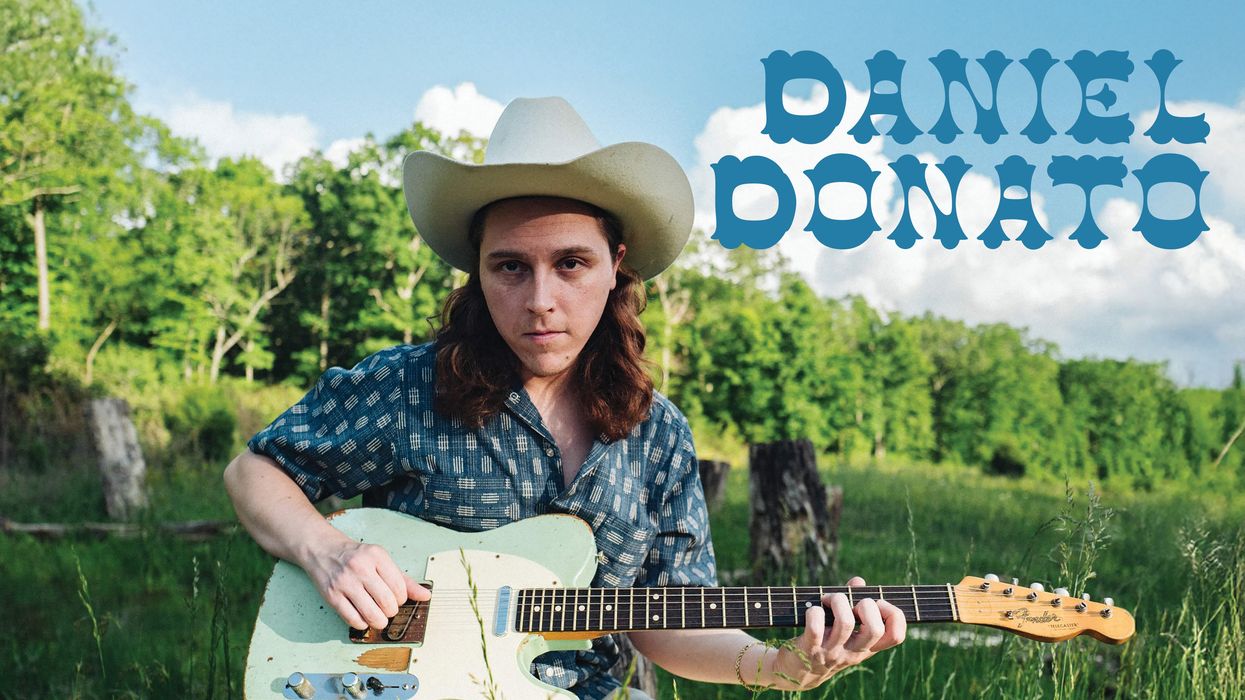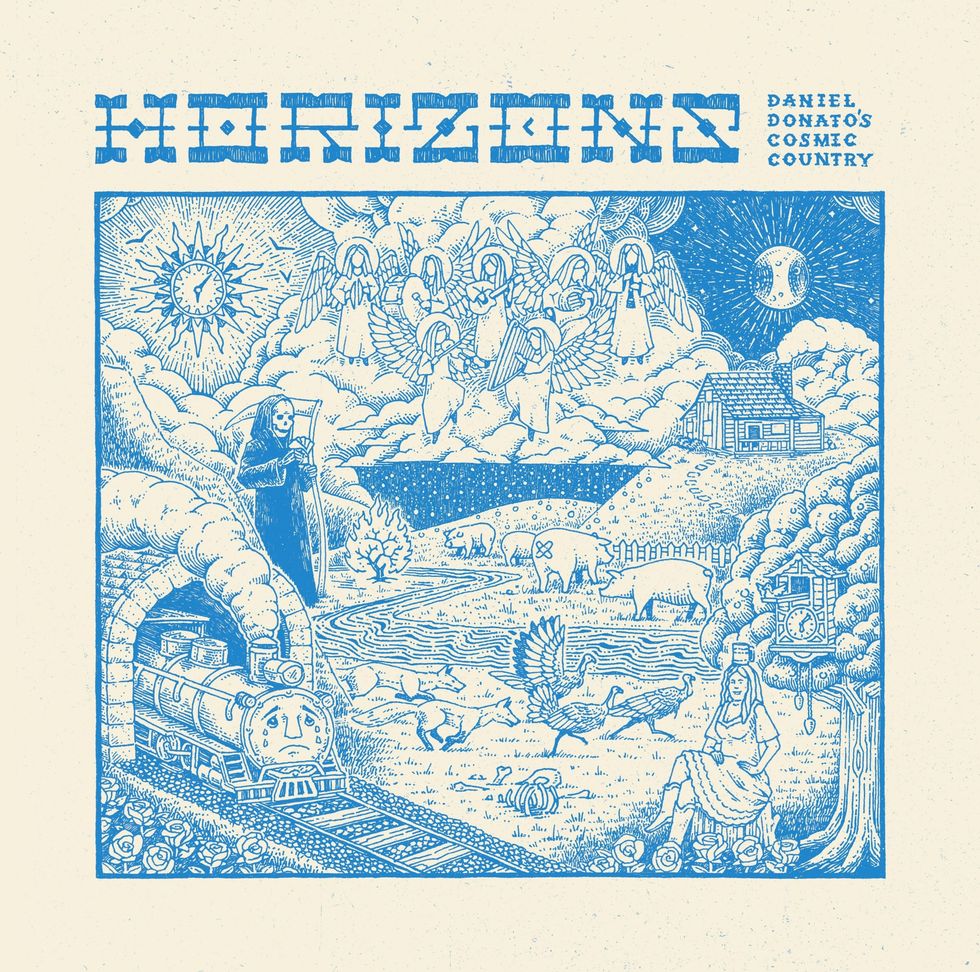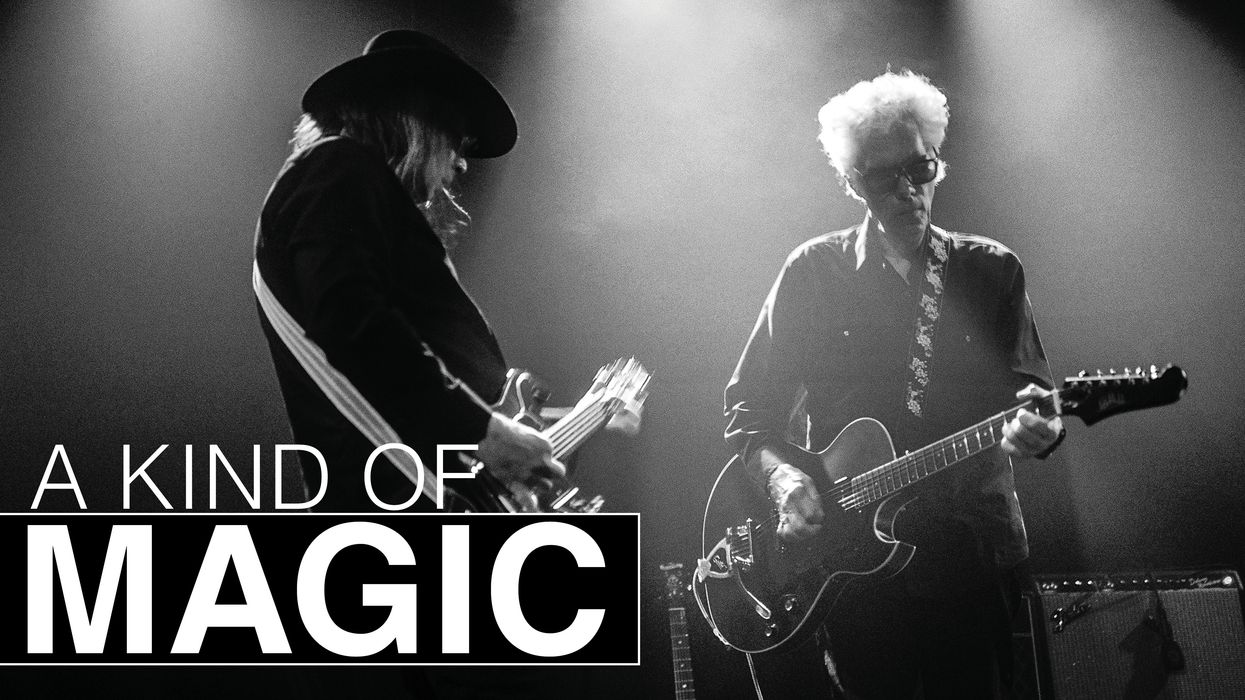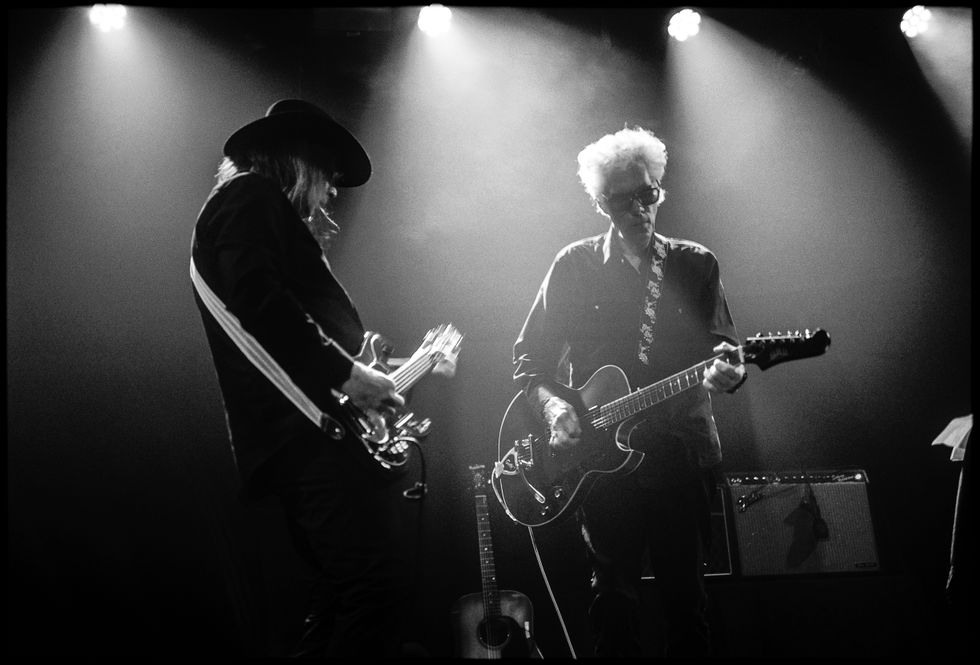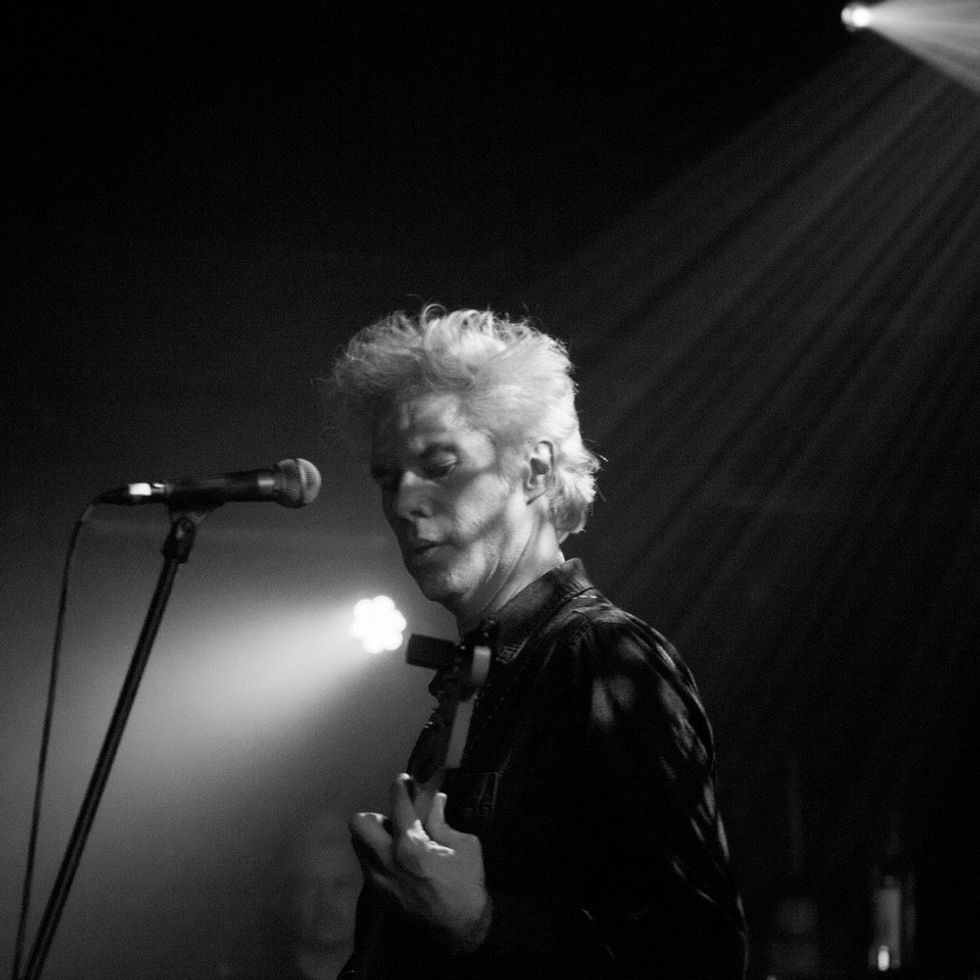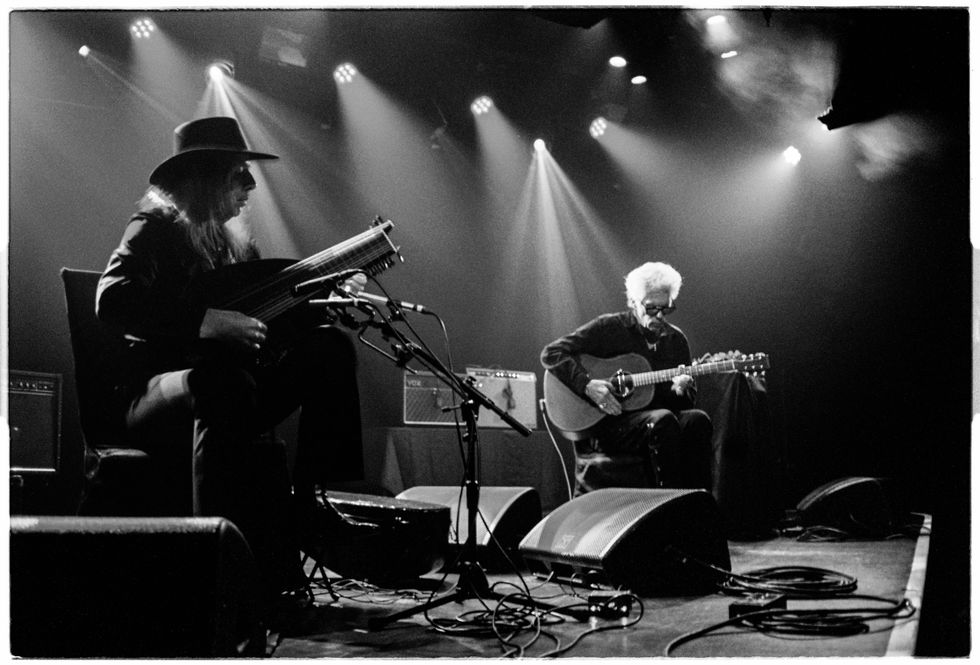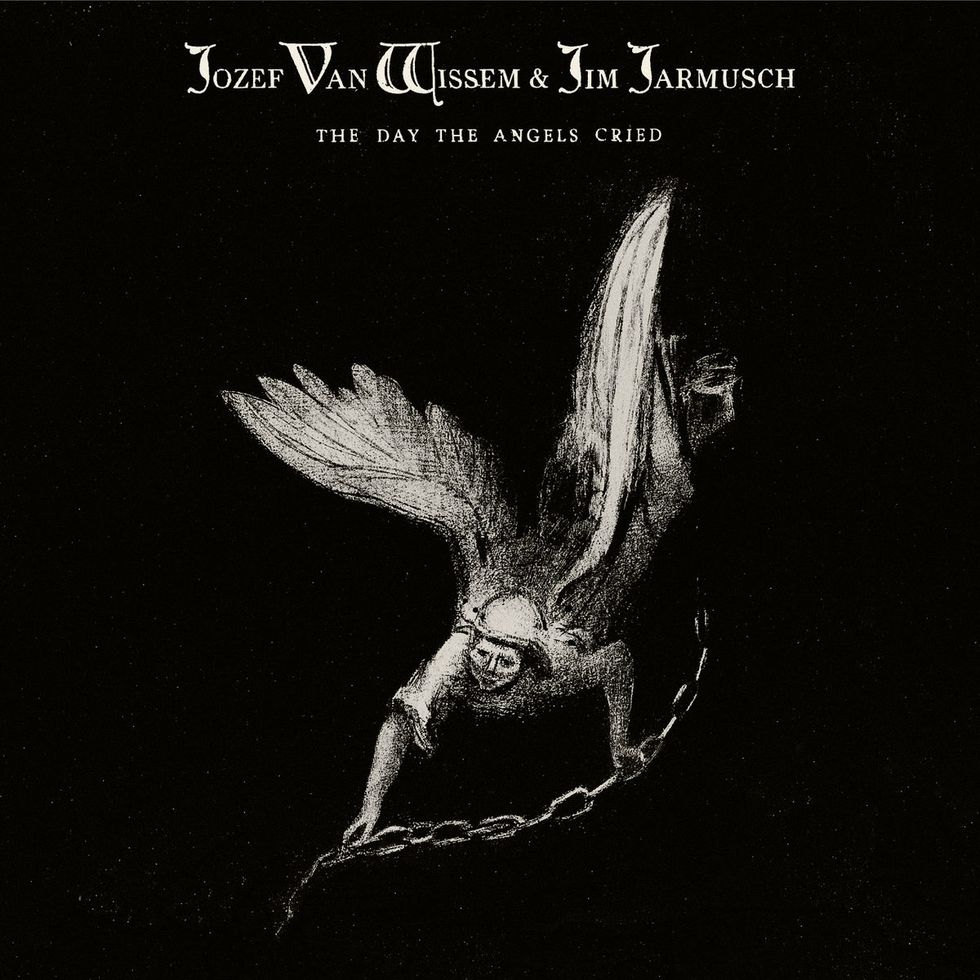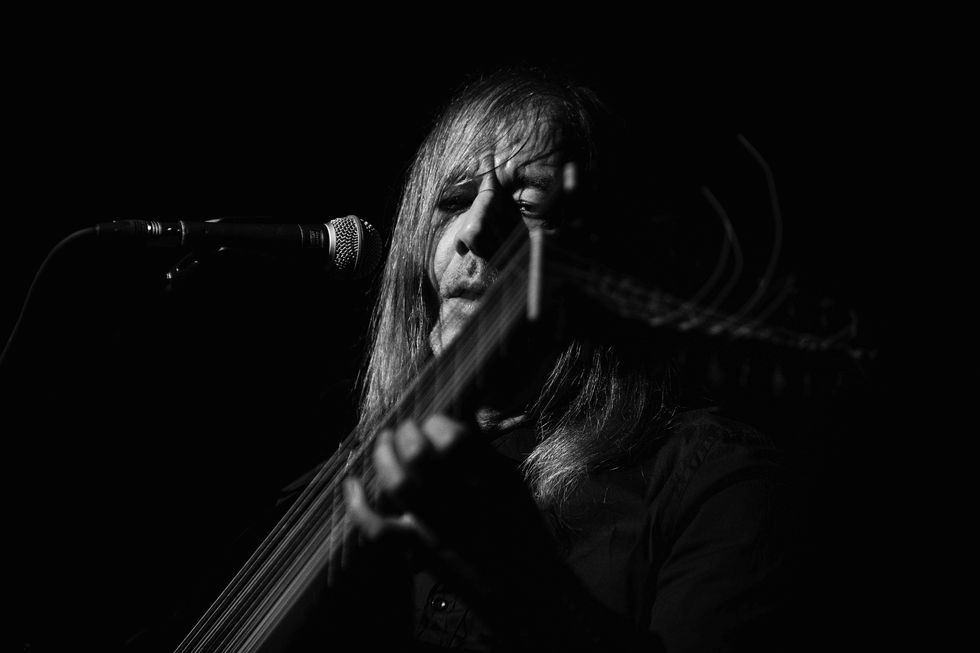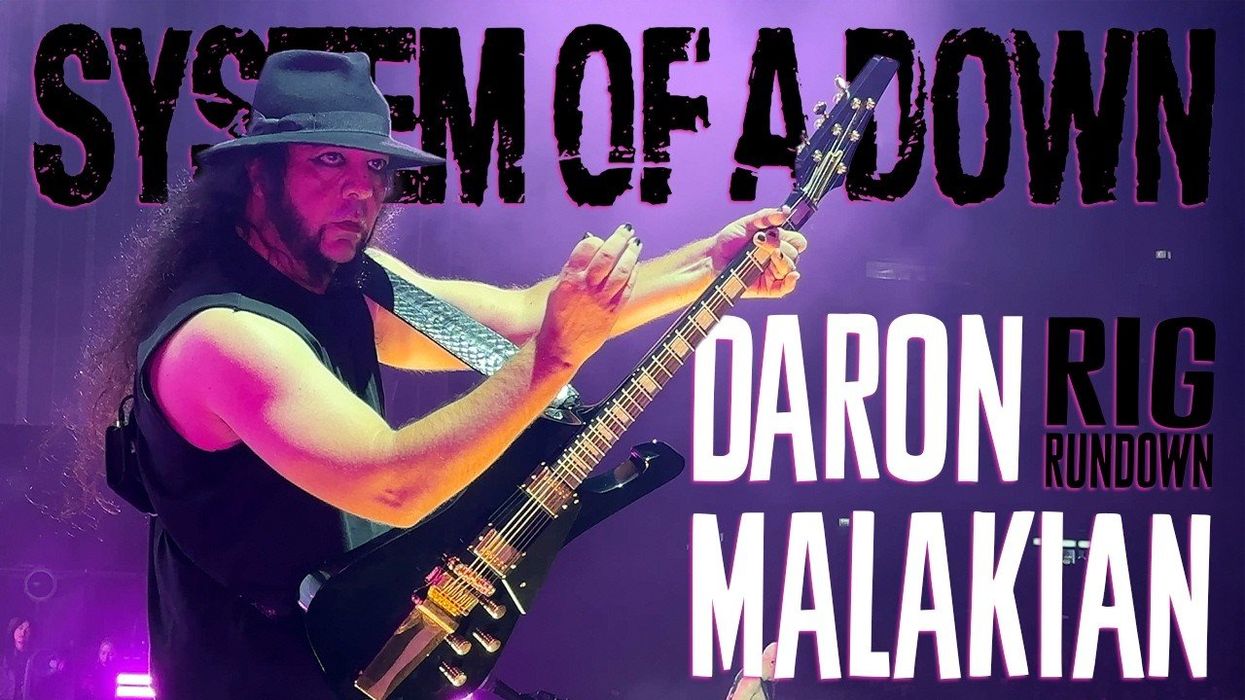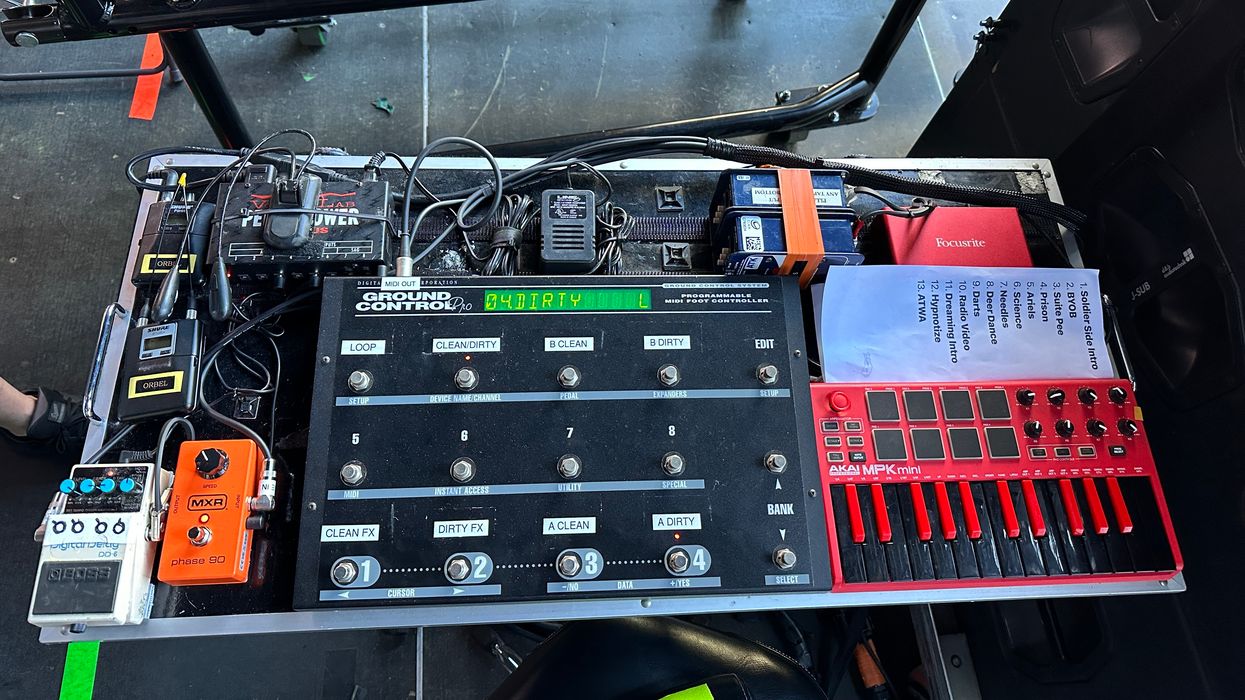I’m stuck in Stevie Van Zandt’s elevator, and the New York City Fire Department has been summoned. It’s early March, and I am trapped on the top floor of a six-story office building in Greenwich Village. On the other side of this intransigent door is Van Zandt’s recording studio, his guitars, amps, and other instruments, his Wicked Cool Records offices, and his man cave. The latter is filled with so much day-glo baby boomer memorabilia that it’s like being dropped into a Milton Glaser-themed fantasy land—a bright, candy-colored chandelier swings into the room from the skylight.
There’s a life-size cameo of a go-go dancer in banana yellow; she’s frozen in mid hip shimmy. One wall displays rock posters and B-movie key art, anchored by a 3D rendering of Cream’s Disraeli Gears album cover that swishes and undulates as you walk past it. Van Zandt’s shelves are stuffed with countless DVDs, from Louis Prima to the J. Geils Band performing on the German TV concert series Rockpalast. There are three copies of Iggy and the Stooges: Live in Detroit. Videos of the great ’60s-music TV showcases, from Hullabaloo to Dean Martin’s The Hollywood Palace, sit here. Hundreds of books about rock ’n’ roll, from Greil Marcus’s entire output to Nicholas Schaffner’s seminal tome, The Beatles Forever, form a library in the next room.
But I haven’t seen this yet because the elevator is dead, and I am in it. Our trap is tiny, about 5' by 5'. A dolly filled with television production equipment is beside me. There’s a production assistant whom I’ve never met until this morning and another person who’s brand new to me, too, Geoff Sanoff. It turns out that he’s Van Zandt’s engineer—the guy who runs this studio. And as I’ll discover shortly, he’s also one of the several sentinels who watch over Stevie Van Zandt’s guitars.
There’s nothing to do now but wait for the NYFD, so Sanoff and I get acquainted. We discover we’re both from D.C. and know some of the same people in Washington’s music scene. We talk about gear. We talk about this television project. I’m here today assisting an old pal, director Erik Nelson, best known for producing Werner Herzog’s most popular documentaries, like Grizzly Man and Cave of Forgotten Dreams. Van Zandt has agreed to participate in a television pilot about the British Invasion. After about half an hour, the elevator doors suddenly slide open, and we’re rescued, standing face-to-face with three New York City firefighters.
As our camera team sets up the gear, Sanoff beckons me to a closet off the studio’s control room. I get the sense I am about to get a consolation prize for standing trapped in an elevator for the last 30 minutes. He pulls a guitar case off the shelf—it’s stenciled in paint with the words “Little Steven” on its top—snaps open the latches, and instantly I am face to face with Van Zandt’s well-worn 1957 Stratocaster. Sanoff hands it to me, and I’m suddenly holding what may as well be the thunderbolt of Zeus for an E Street Band fan. My jaw drops when he lets me plug it in so he can get some levels on his board, and the clean, snappy quack of the nearly 70-year-old pickups fills the studio. For decades, Springsteen nuts have enjoyed a legendary 1978 filmed performance of “Rosalita” from Phoenix, Arizona, that now lives on YouTube. This is the Stratocaster Van Zandt had slung over his shoulder that night. It’s the same guitar he wields in the famous No Nukes concert film shot at Madison Square Garden a year later, in 1979. My mind races. The British Invasion is all well and essential. But now I’m thinking about Van Zandt’s relationship with his guitars.
Stevie Van Zandt's Gear
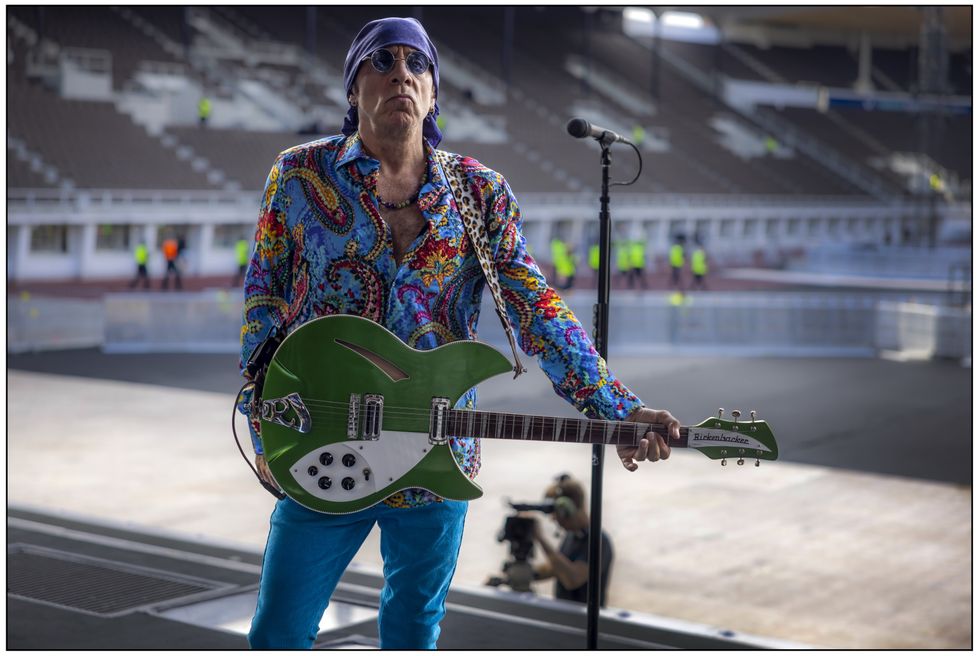
Van Zandt’s guitar concierge Andy Babiuk helped him plunge deeper down the Rickenbacker rabbit hole. Currently, Van Zandt has six Rickenbackers backstage: two 6-strings and four 12-strings.
Guitars
- 1957 Fender Stratocaster (studio only)
- ’80s Fender ’57 Stratocaster reissue “Number One”
- Gretsch Tennessean
- 1955 Gibson Les Paul Custom “Black Beauty” (studio only)
- Rickenbacker Fab Gear 2024 Limited Edition ’60s Style 360 Model (candy apple green)
- Rickenbacker Fab Gear 2023 Limited Edition ’60s Style 360 Model (snowglo)
- Rickenbacker 2018 Limited Edition ’60s Style 360 Fab Gear (jetglo)
- Two Rickenbacker 1993Plus 12-strings (candy apple purple and SVZ blue)
- Rickenbacker 360/12C63 12-string (fireglo)
- Vox Teardrop (owned by Andy Babiuk)
Amps
- Two Vox AC30s
- Two Vox 2x12 cabinets
Effects
- Boss Space Echo
- Boss Tremolo
- Boss Rotary Ensemble
- Durham Electronics Sex Drive
- Durham Electronics Mucho Busto
- Durham Electronics Zia Drive
- Electro-Harmonix Satisfaction
- Ibanez Tube Screamer
- Voodoo Labs Ground Control Pro switcher
Strings and Picks
- D’Addario (.095–.44)
- D’Andrea Heavy
Van Zandt has reached a stage of reflection in his career. Besides the Grammy-nominated HBO film, Stevie Van Zandt: Disciple, which came out in 2024, he recently wrote and published his autobiography, Unrequited Infatuations (2021), a rollicking read in which he pulls no punches and makes clear he still strives to do meaningful things in music and life.
His laurels would weigh him down if they were actually wrapped around his neck. In the E Street Band, Van Zandt has participated in arguably the most incredible live group in rock ’n’ roll history. And don’t forget Southside Johnny and the Asbury Jukes or Little Steven and the Disciples of Soul. He created both the Underground Garage and Outlaw Country radio channels on Sirius/XM. He started a music curriculum program called TeachRock that provides no-cost resources and other programs to schools across the country. Then there’s the politics. Via his 1985 record, Sun City, Van Zandt is credited with blasting many of the load-bearing bricks that brought the walls of South African apartheid tumbling into dust. He also acted in arguably the greatest television drama in American history, with his turn as Silvio Dante in The Sopranos.
Puzzlingly, Van Zandt’s autobiography lacks any detail on his relationship with the electric guitar. And Sanoff warns me that Van Zandt is “not a gearhead.” Instead he has an organization in place to keep his guitar life spinning like plates on the end of pointed sticks. Besides Sanoff, there are three others: Ben Newberry has been Van Zandt’s guitar tech since the beginning of 1982. Andy Babiuk, owner of Rochester, New York, guitar shop Fab Gear and author of essential collector reference books Beatles Gear and Rolling Stones Gear (the latter co-authored by Greg Prevost) functions as Van Zandt’s guitar concierge. Lastly, luthier Dave Petillo, based in Asbury Park, New Jersey, oversees all the maintenance and customization on Van Zandt’s axes.
“I took one lesson, and they start to teach you the notes. I don’t care about the notes.” —Stevie Van Zandt
I crawl onto Zoom with Van Zandt for a marathon session and come away from our 90 minutes with the sense that he is a man of dichotomies. Sure, he’s a guitar slinger, but he considers his biggest strengths to be as an arranger, producer, and songwriter. “I don’t feel that being a guitar player is my identity,” he tells me. “For 40 years, ever since I made my first solo record, I just have not felt that I express myself as a guitar player. I still enjoy it when I do it; I’m not ambivalent. When I play a solo, I am in all the way, and I play a solo like I would like to hear if I were in the audience. But the guitar part is really part of the song’s arrangement. And a great solo is a composed solo. Great solos are ones you can sing, like Jimi Hendrix’s solo in ‘All Along the Watchtower.’”
In his autobiography, Van Zandt mentions that his first guitar was an acoustic belonging to his grandfather. “I took one lesson, and they start to teach you the notes. I don’t care about the notes,” Van Zandt tells me. “The teacher said I had natural ability. I’m thinking, if I got natural ability, then what the fuck do I need you for? So I never went back. After that, I got my first electric, an Epiphone. It was about slowing down the records to figure out with my ear what they were doing. It was seeing live bands and standing in front of that guitar player and watching what they were doing. It was praying when a band went on TV that the cameraman would occasionally go to the right place and show what the guitar player was doing instead of putting the camera on the lead singer all the time. And I’m sure it was the same for everybody. There was no concept of rock ’n’ roll lessons. School of Rock wouldn’t exist for another 30 years. So, you had to go to school yourself.”
By the end of the 1960s, Van Zandt tells me he had made a conscious decision about what kind of player he wanted to be. “I realized that I really wasn’t that interested in becoming a virtuoso guitar player, per se. I was more interested in making sure I could play the guitar solo that would complement the song. I got more into the songs than the nature of musicianship.”
After the Beatles and the Stones broke the British Invasion wide open, bands like Cream and the Yardbirds most influenced him. “George Harrison would have that perfect 22-second guitar solo,” Van Zandt remembers. “Keith Richards. Dave Davies. Then, the harder stuff started coming. Jeff Beck in the Yardbirds. Eric Clapton with things like ‘White Room.’ But the songs stayed in a pop configuration, three minutes each or so. You’d have this cool guitar-based song with a 15-second, really amazing Jeff Beck solo in it. That’s what I liked. Later, the jam bands came, but I was not into that. My attention deficit disorder was not working for the longer solos,” he jokes. Watch a YouTube video of any recent E Street Band performance where Van Zandt solos, and the punch and impact of his approach and attack are apparent. At Nationals Park in Washington, D.C., last year, his solo on “Rosalita” was 13 powerful seconds.
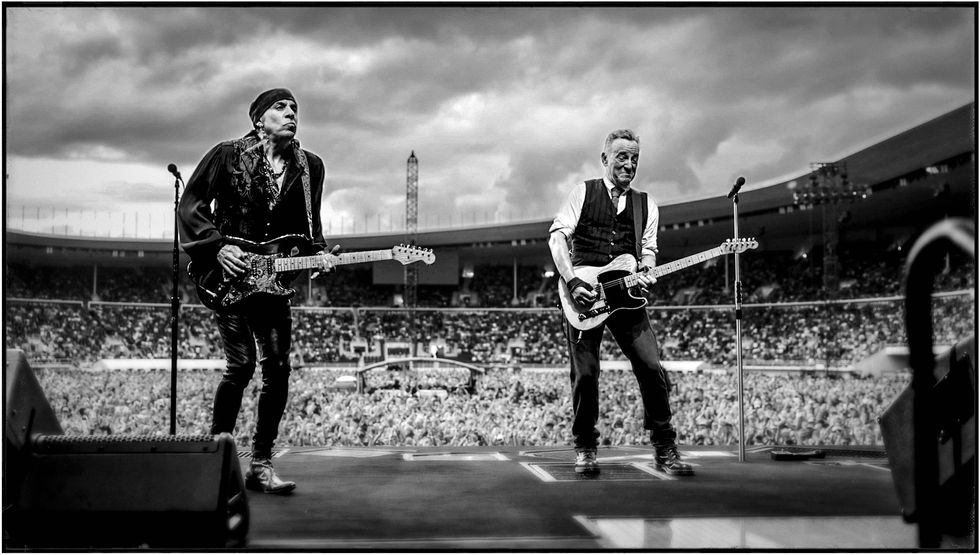
Van Zandt and Bruce Springsteen’s relationship goes back to their earliest days on the Jersey shore. “Everybody had a different guitar; your guitar was your identity,” recalls Van Zandt. “At some point, a couple of years later, I remember Bruce calling me and asking me for my permission to switch to Telecaster. At that point, I was ready to switch to Stratocaster.”
Photo by Pamela Springsteen
Van Zandt left his Epiphone behind for his first Fender. “I started to notice that the guitar superstars at the time were playing Telecasters. Mike Bloomfield. Jeff Beck. Even Eric Clapton played one for a while,” he tells me. “I went down to Jack’s Music Shop in Red Bank, New Jersey, because he had the first Telecaster in our area and couldn’t sell it; it was just sitting there. I bought it for 90 bucks.”
In those days, and around those parts, players only had one guitar. Van Zandt recalls, “Everybody had a different guitar; your guitar was your identity. At some point, a couple of years later, I remember Bruce calling me and asking me for my permission to switch to Telecaster. At that point, I was ready to switch to Stratocaster, because Jimi Hendrix had come in and Jeff Beck had switched to a Strat. They all kind of went from Telecaster to Les Pauls. And then some of them went on to the Stratocaster. For me, the Les Paul was just too out of reach. It was too expensive, and it was just too heavy. So I said, I’m going to switch to a Stratocaster. It felt a little bit more versatile.”
Van Zandt still employs Stratocasters, and besides the 1957 I strummed, he was seen with several throughout the ’80s and ’90s. But for the last 20 or 25 years, Van Zandt has mainly wielded a black Fender ’57 Strat reissue from the ’80s with a maple fretboard and a gray pearloid pickguard. He still uses that Strat—dubbed “Number One”—but the pickguard has been switched to one sporting a purple paisley pattern that was custom-made by Dave Petillo.
Petillo comes from New Jersey luthier royalty and followed in the footsteps of his late father, Phil Petillo. At a young age, the elder Petillo became an apprentice to legendary New York builder John D’Angelico. Later, he sold Bruce Springsteen the iconic Fender Esquire that’s seen on the Born to Run album cover and maintained and modified that guitar and all of Bruce’s other axes until he passed away in 2010. Phil worked out of a studio in the basement of their home, not far from Asbury Park. Artists dropped in, and Petillo has childhood memories of playing pick-up basketball games in his backyard with members of the E Street Band. (He also recalls showing his Lincoln Logs to Johnny Cash and once mistaking Jerry Garcia for Santa Claus.)
“I was more interested in making sure I could play the guitar solo that would complement the song. I got more into the songs than the nature of musicianship.” —Stevie Van Zandt
“I’ve known Stevie Van Zandt my whole life,” says Petillo. “My dad used to work on his 1957 Strat. That guitar today has updated tuners, a bone nut, new string trees, and a refret that was done by Dad long ago. I think one volume pot may have been changed. But it still has the original pickups.” Petillo is responsible for a lot of the aesthetic flair seen on Van Zandt’s instruments. He continues, “Stevie is so much fun to work with. I love incorporating colors into things, and Stevie gets that. When you talk to a traditional Telecaster or Strat player, and you say, ‘I want to do a tulip paisley pickguard in neon blue-green,’ they’re like, ‘Holy cow, that’s too much!’ But for Stevie, it’s just natural. So I always text him with pickguard designs, asking him, ‘Which one do you like?’ And he calls me a wild man; he says, ‘I don’t have that many Strats to put them on!’ But I’ll go to Ben Newberry and say, ‘Ben, I made these pickguards; let’s get them on the guitar. And I’ll go backstage, and we’ll put them on. I just love that relationship; Stevie is down for it.”
Petillo takes care of the electronics on Van Zandt’s guitars. Almost all of the Strats are modified with an internal Alembic Stratoblaster preamp circuit, which Van Zandt can physically toggle on and off using a switch housed just above the input jack. Van Zandt tells me, “That came because I got annoyed with the whole pedal thing. I’m a performer onstage, and I’m integrated with the audience and I like the freedom to move. And if I’m across the stage and all of a sudden Bruce nods to me to take a solo, or there’s a bit in the song that requires a little bit of distortion, it’s just easier to have that; sometimes, I’ll need that extra little boost for a part I’m throwing in, and it’s convenient.”
In recent times, Van Zandt has branched out from the Stratocaster, which has a lot to do with Andy Babiuk's influence. The two met 20 years ago, and Babiuk’s band, the Chesterfield Kings, is on Van Zandt’s Wicked Cool Records. “He’d call me up and ask me things like, ‘What’s Brian Jones using on this song?’” explains Babiuk. “When I’d ask him why, he’d tell me, ‘Because I want to have that guitar.’ It’s a common thing for me to get calls and texts from him like that. And there’s something many people overlook that Stevie doesn’t advertise: He’s a ripping guitar player. People think of him as playing chords and singing backup for Bruce, but the guy rips. And not just on guitar, on multiple instruments.”
Van Zandt tells me he wanted to bring more 12-string to the E Street Band this tour, “just to kind of differentiate the tone.” He explains, “Nils is doing his thing, and Bruce is doing his thing, and I wanted to do more 12-string.” He laughs, “I went full Paul Kantner!” Babiuk helped Van Zandt plunge deeper down the Rickenbacker rabbit hole. Currently, Van Zandt has six Rickenbackers backstage: two 6-strings and four 12-strings. Each 12-string has a modified nut made by Petillo from ancient woolly mammoth tusk, and the D, A, and low E strings are inverted with their octave.
Van Zandt explains this to me: “I find that the strings ring better when the high ones are on top. I’m not sure if that’s how Roger McGuinn did it, but it works for me. I’m also playing a wider neck.”
Babiuk tells me about a unique Rick in Van Zandt’s rack of axes: “I know the guys at Rickenbacker well, and they did a run of 30 basses in candy apple purple for my shop. I showed one to Stevie, and purple is his color; he loves it. He asked me to get him a 12-string in the same color, and I told him, ‘They don’t do one-offs; they don’t have a custom shop,’ but it’s hard to say no to the guy! So I called Rickenbacker and talked them into it. I explained, ‘He’ll play it a lot on this upcoming tour.’ They made him a beautiful one with his OM logo.”
The purple one-off is a 1993Plus model and sports a 1 3/4" wide neck—1/8" wider than a normal Rickenbacker. Van Zandt loved it so much that he had Babiuk wrestle with Rickenbacker again to build another one in baby blue. Petillo has since outfitted them with paisley-festooned custom pickguards. When guitar tech Newberry shows me these unique axes backstage, I can see the input jack on the purple guitar is labeled with serial number 01001.
“Some of my drive is based on gratitude,” says Van Zandt, “feeling like we are the luckiest guys in the luckiest generation ever.”
Photo by Rob DeMartin
Van Zandt also currently plays a white Vox Teardrop. That guitar is a prototype owned by Babiuk. “Stevie wanted a Teardrop,” Babiuk tells me, “but I explained that the vintage ones are hit and miss—the ones made in the U.K. were often better than the ones manufactured in Italy. Korg now owns Vox, and I have a new Teardrop prototype from them in my personal collection. When I showed it to him, he loved it and asked me to get him one. I had to tell him, ‘I can’t; it’s a prototype, there’s only one,’ and he asked me to sell him mine,” he chuckles. “I told him, ‘It’s my fucking personal guitar, it’s not for sale!’ So I ended up lending it to him for this tour, and I told him, ‘Remember, this is my guitar; don’t get too happy with it, okay?’
“He asked me why that particular guitar sounds and feels so good. Besides being a prototype built by only one guy, the single-coil pickups’ output is abnormally hot, and the neck feels like a nice ’60s Fender neck. Stevie’s obviously a dear friend of mine, and he can hold onto it for as long as he wants. I’m glad it’s getting played. It was just hanging in my office.”
Van Zandt tells me how Babiuk’s Vox Teardrop sums up everything he wants from his tone, and says, “It’s got a wonderfully clean, powerful sound. Like Brian Jones got on ‘The Last Time.’ That’s my whole thing; that’s the trick—trying to get the power without too much distortion. Bruce and Nils get plenty of distortion; I am trying to be the clean rhythm guitar all the time.”
If Van Zandt has a consigliere like Tony Soprano had Silvio Dante, that’s Newberry. Newberry has tech’d nearly every gig with Van Zandt since 1982. “Bruce shows move fast,” he tells me. “So when there’s a guitar change for Stevie, and there are many of them, I’m at the top of the stairs, and we switch quickly. There’s maybe one or two seconds, and if he needs to tell me something, I hear it. He’s Bruce’s musical director, so he may say something like, ‘Remind me tomorrow to go over the background vocals on “Ghosts,”’ or something like that. And I take notes during the show.”
“Everybody had a different guitar; your guitar was your identity. At some point, a couple of years later, I remember Bruce calling me and asking me for my permission to switch to a Telecaster.” —Stevie Van Zandt
When I ask Newberry how he defines Van Zandt’s relationship to the guitar, he doesn’t hesitate, snapping back, “It’s all in his head. His playing is encyclopedic, whether it’s Bruce or anything else. He may show up at soundcheck and start playing the Byrds, but it’s not ‘Tambourine Man,’ it’s something obscure like ‘Bells of Rhymney.’ People may not get it, but I’ve known him long enough to know what’s happening. He’s got everything already under his fingers. Everything.”
As such, Van Zandt says he never practices. “The only time I touch a guitar between tours is if I’m writing something or maybe arranging backing vocal harmonies on a production,” he tells me.
Before we say goodbye, I tell Van Zandt about my time stuck in his elevator, and his broad grin signals that I may not be the only one to have suffered that particular purgatory. When I ask him about the 1957 Stratocaster I got to play upon my release, he recalls: “Bruce Springsteen gave me that guitar. I’ve only ever had one guitar stolen in my life, and it was in the very early days of my joining the E Street Band. I only joined temporarily for what I thought would be about seven gigs, and in those two weeks or so, my Stratocaster was stolen. It was a 1957 or 1958. Bruce felt bad about that and replaced that lost guitar with this one. So I’ve had it a long, long time. Once that first one was stolen, I decided I would resist having a personal relationship with any one guitar. But that one being a gift from Bruce makes it special. I will never take it back on the road.”
After 50 years of rock ’n’ roll, if there is one word to sum up Stevie Van Zandt, it may be “restless”—an adjective you sense from reading his autobiography. He gets serious and tells me, “I’m always trying to catch up. The beginning of accomplishing something came quite late to me. I feel like I haven’t done nearly enough. What are we on this planet trying to do?” he asks rhetorically. “We’re trying to realize our potential and maybe leave this place one percent better for the next guy. And some of my drive is based on gratitude, feeling like we are the luckiest guys in the luckiest generation ever. That’s what I’m doing: I want to give something back. I feel an obligation.”
YouTube It
“Rosalita” is a perennial E Street Band showstopper. Here’s a close-up video from Philadelphia’s Citizens Bank Park last summer. Van Zandt’s brief but commanding guitar spotlight shines just past the 4:30 mark.
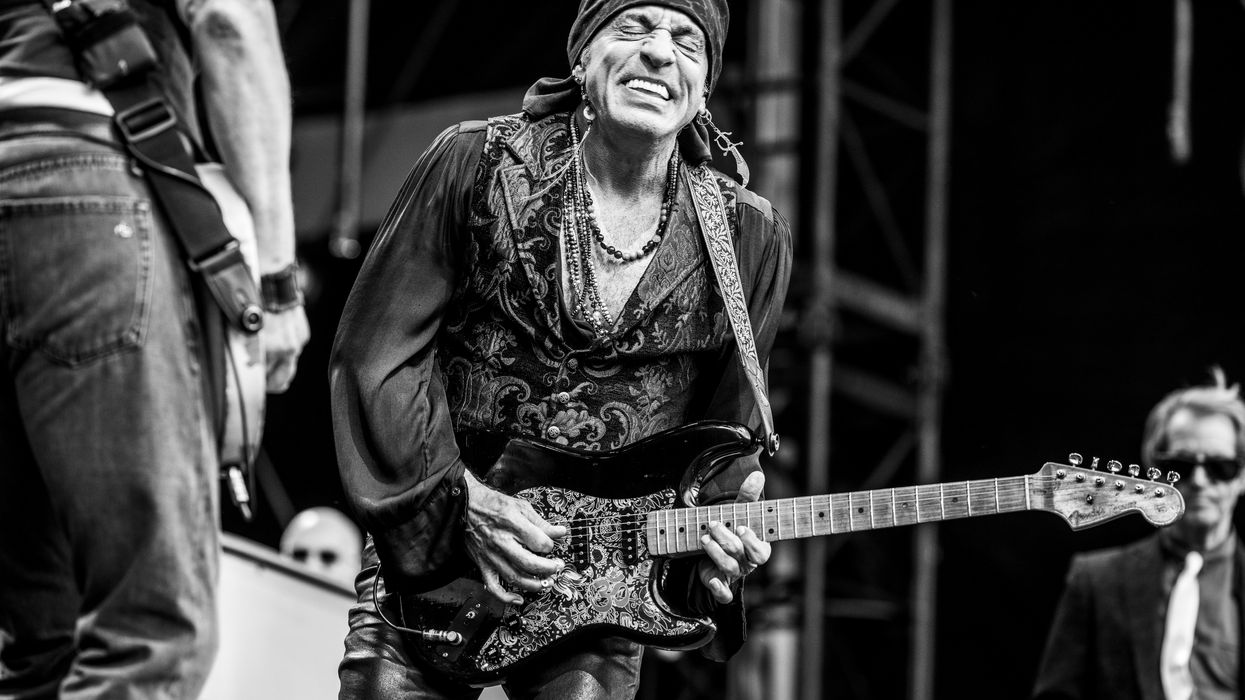




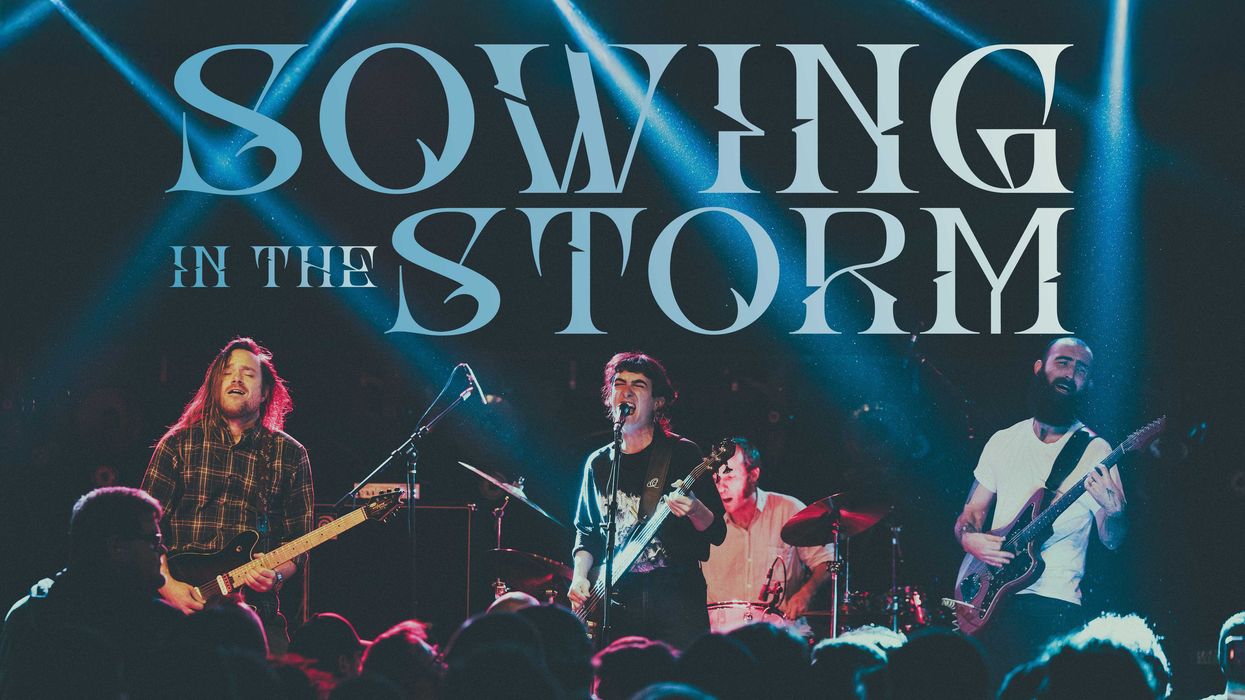

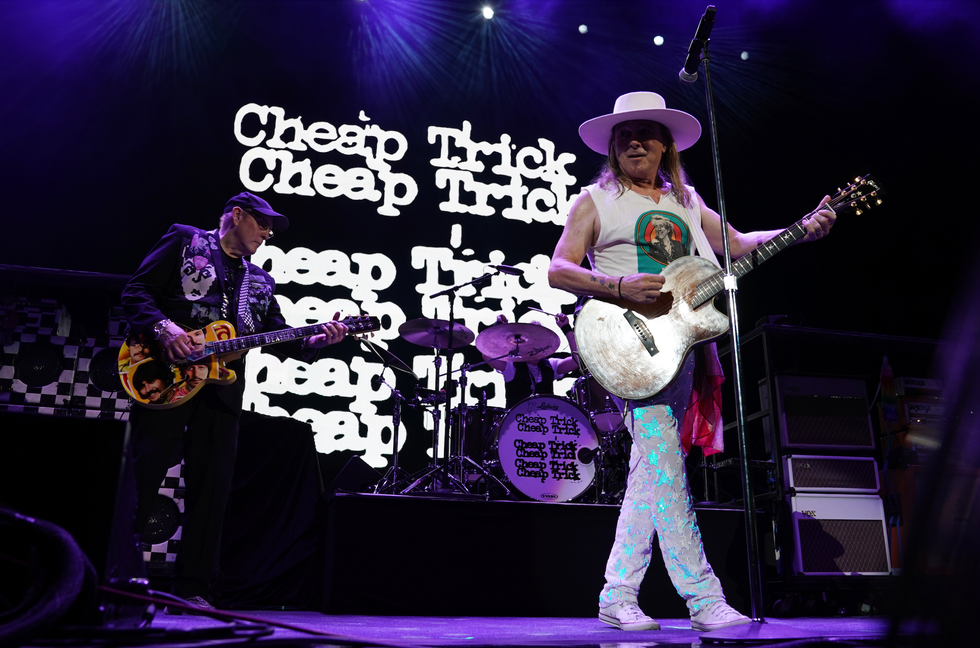
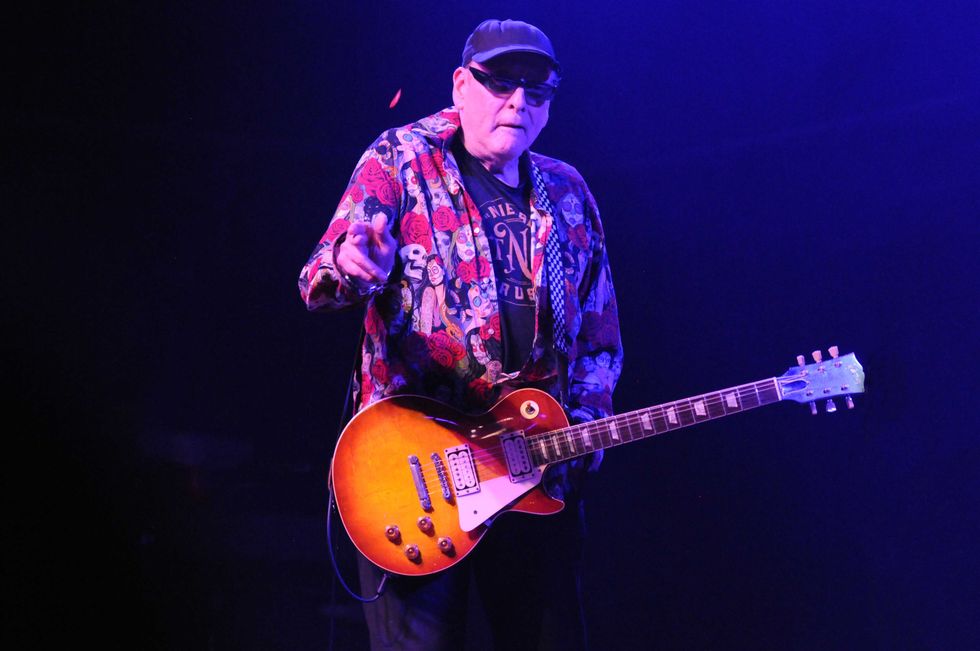

![Devon Eisenbarger [Katy Perry] Rig Rundown](https://www.premierguitar.com/media-library/youtube.jpg?id=61774583&width=1245&height=700&quality=70&coordinates=0%2C0%2C0%2C0)





